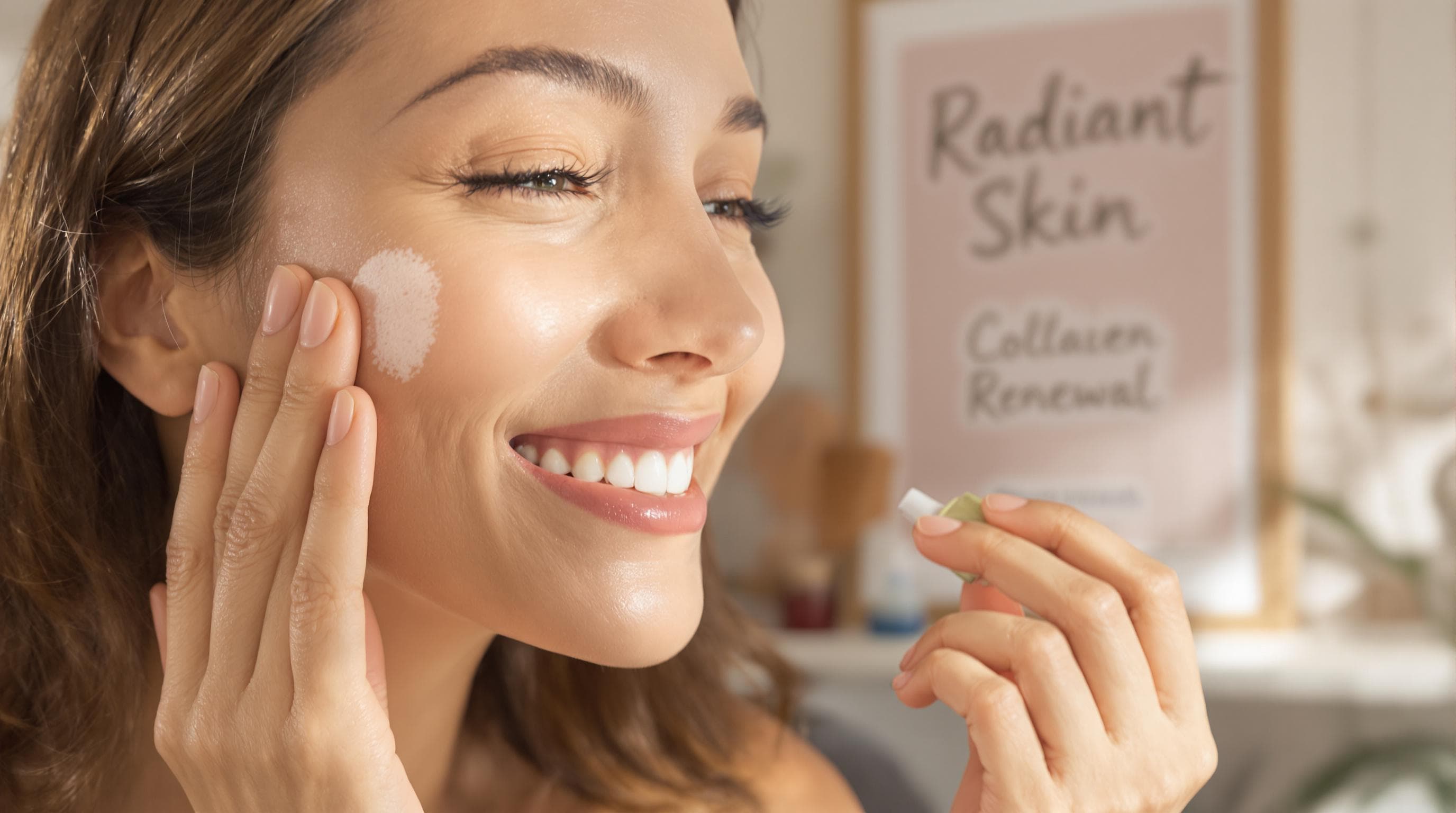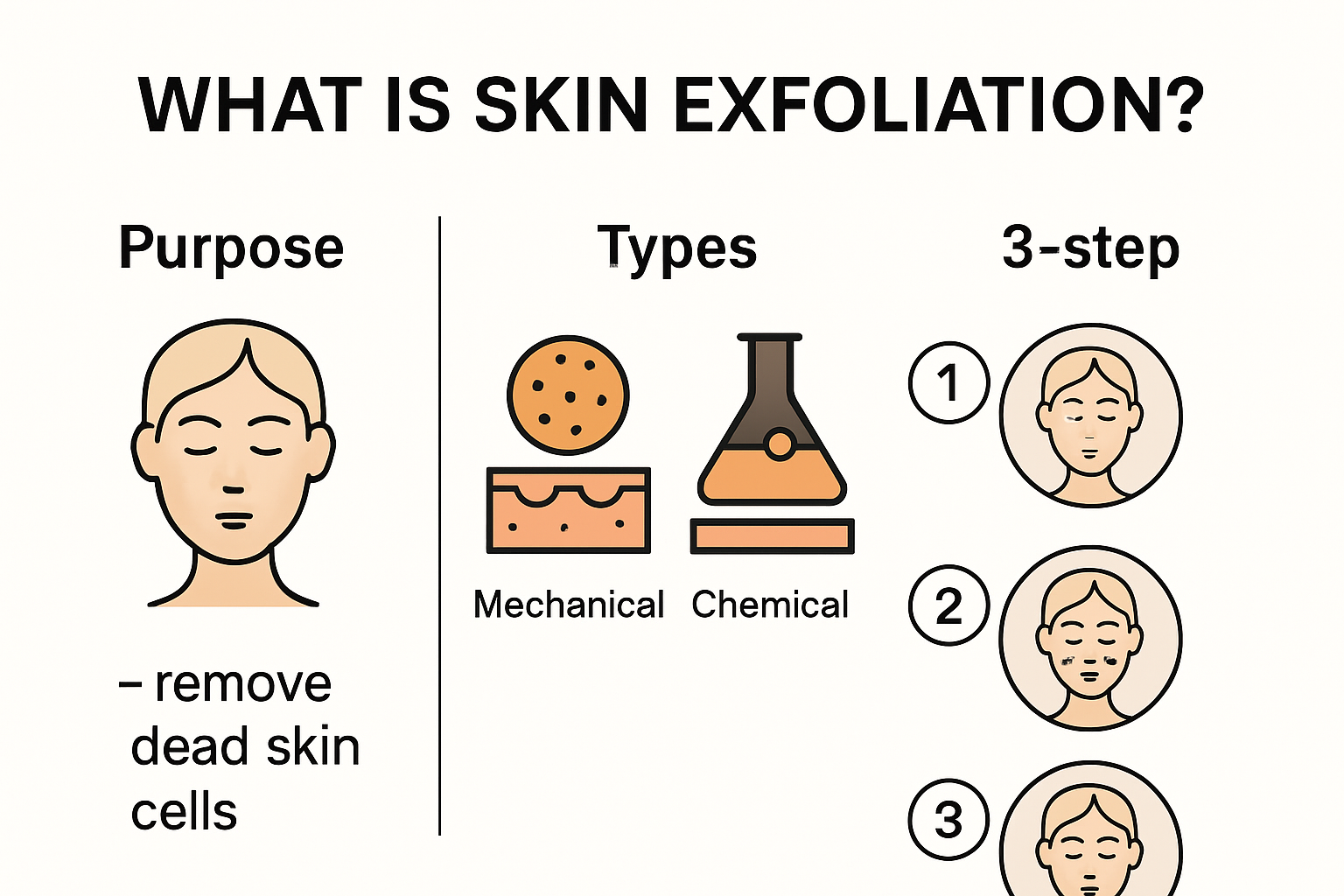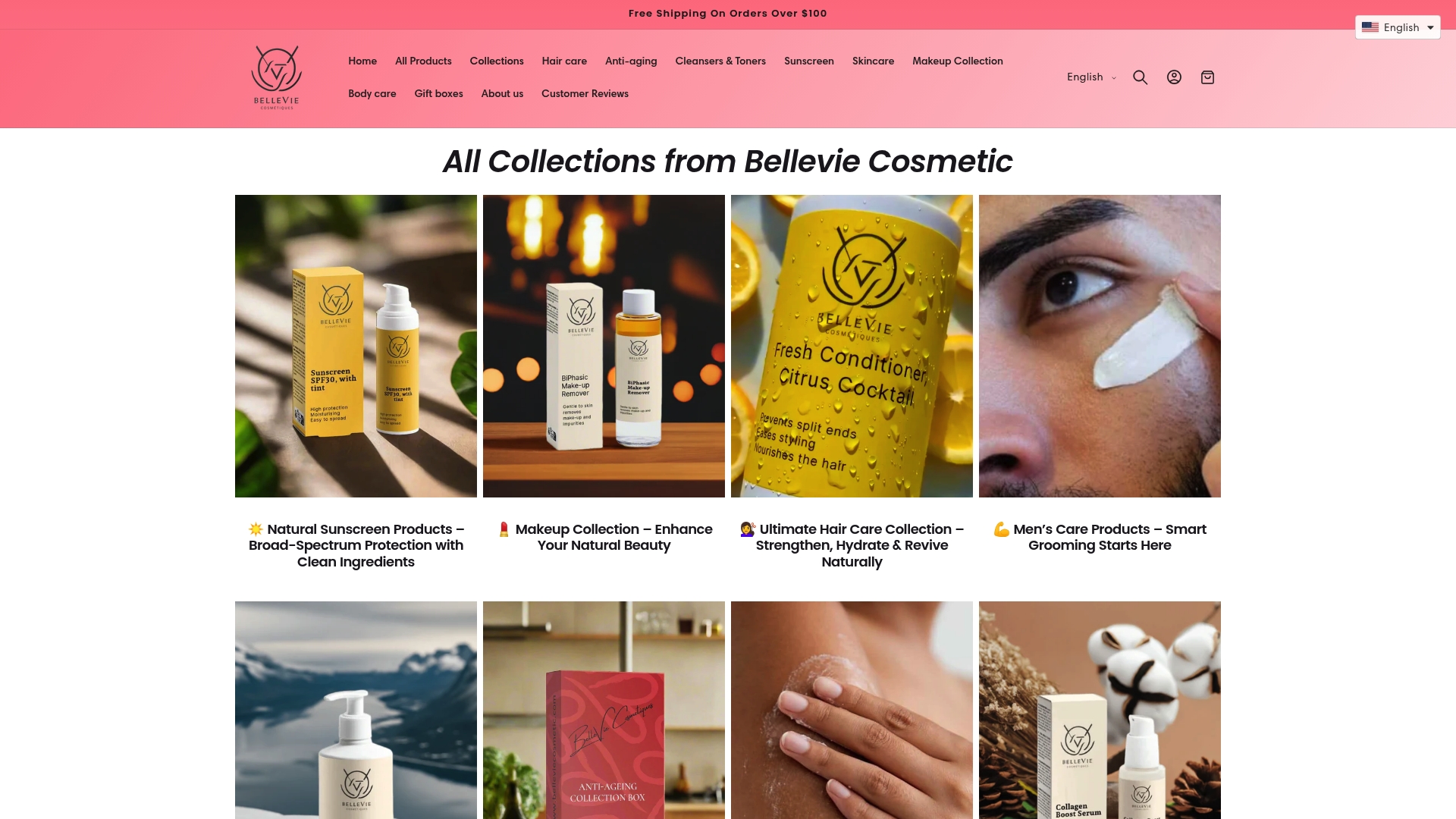Exfoliating your skin can do more than just make it feel smooth. Skin cell turnover slows from a 28-day cycle to as long as 60 days as we age, often turning what should be a healthy glow into a dull complexion. Here is the curveball. Most people scrub away without realizing that over-exfoliating can actually make your skin less healthy and more sensitive. Discover what really matters when it comes to smarter exfoliation without the common pitfalls.
Table of Contents
- Understanding What Is Skin Exfoliation
- Benefits Of Exfoliation For Anti-Aging And Glow
- Choosing The Best Exfoliation Methods For Your Skin
- Exfoliation Tips For Sensitive, Zero Waste, And Clean Beauty Routines
Quick Summary
| Takeaway | Explanation |
|---|---|
| Understanding Exfoliation | Skin exfoliation removes dead skin cells, revealing a healthier complexion and enhancing the effectiveness of skincare products. Regular exfoliation can boost skin cell turnover, which slows with age. |
| Choosing the Right Method | Select exfoliation methods based on your skin type. Sensitive skin benefits from gentler chemical exfoliants, while oily skin can tolerate stronger mechanical and chemical methods. |
| Frequency and Balance | Exfoliate 1-3 times per week, adjusting based on your skin’s sensitivity. Over-exfoliation can harm the skin barrier, leading to irritation. |
| Product Absorption and Radiance | Exfoliating not only improves product absorption but also enhances skin radiance by diminishing dullness and promoting an even skin tone. |
| Sustainable Exfoliation | For a more environmentally conscious approach, consider natural scrubs, reusable tools, and DIY exfoliation using kitchen ingredients while avoiding products with plastic microbeads. |
Understanding What is Skin Exfoliation
Skin exfoliation represents a fundamental skincare technique designed to remove dead skin cells and reveal a fresher, more radiant complexion. At its core, this process targets the outermost layer of skin, helping individuals maintain healthy, glowing skin by strategically eliminating accumulated cellular debris.
The Science Behind Skin Cell Renewal
Harvard Health explains that exfoliation involves removing dead skin cells from the skin’s surface, which can significantly enhance skin brightness and improve the effectiveness of subsequent skincare treatments. Our skin naturally undergoes a cellular turnover process, where new cells are continuously generated while older cells migrate toward the surface. However, this process can slow down with age, leading to a buildup of dead skin cells that can make the complexion appear dull and uneven.
The natural cell renewal cycle typically takes approximately 28 days for younger individuals, but this timeline can extend to 40-60 days as we age. By implementing a strategic exfoliation routine, individuals can artificially accelerate this process, stimulating faster cell turnover and promoting a more youthful appearance.
Mechanical vs Chemical Exfoliation Methods
Exfoliation techniques are broadly categorized into two primary methods: mechanical and chemical. Research from Harvard Medical experts distinguishes these approaches based on how dead skin cells are removed.
Mechanical Exfoliation
- Uses physical tools like brushes, scrubs, or textured sponges
- Directly removes dead skin cells through manual manipulation
- Best for individuals with resilient, non-sensitive skin types
Chemical Exfoliation
- Utilizes specific acids like alpha-hydroxy acids (AHAs) or beta-hydroxy acids (BHAs)
- Dissolves the bonds between dead skin cells, allowing them to be easily removed
- Provides a gentler approach suitable for sensitive skin types
Here is a table summarizing the key differences between mechanical and chemical exfoliation methods:
| Method | How It Works | Best For | Examples |
|---|---|---|---|
| Mechanical Exfoliation | Physically scrubs off dead skin cells | Resilient, non-sensitive skin | Brushes, scrubs, textured sponges |
| Chemical Exfoliation | Dissolves bonds between dead skin cells with acids | Sensitive or most skin types | AHAs (glycolic, lactic), BHAs, enzymes |
Potential Benefits of Regular Exfoliation
Consistent exfoliation offers numerous skin health advantages. Clinical research suggests that regular exfoliation can stimulate collagen production, a critical protein responsible for maintaining skin elasticity and firmness. This process potentially reduces the appearance of fine lines and promotes a more youthful complexion.
Additionally, exfoliation helps unclog pores, preventing potential breakouts and allowing skincare products to penetrate more effectively. By removing the barrier of dead skin cells, serums, moisturizers, and treatments can interact more directly with living skin cells, maximizing their potential benefits.
However, it is crucial to approach exfoliation with care. Over-exfoliation can damage the skin’s protective barrier, leading to increased sensitivity, inflammation, and potential long-term skin health issues. Understanding your unique skin type and implementing a balanced exfoliation strategy is key to achieving optimal results.
Individuals should start with gentle exfoliation techniques, gradually increasing frequency and intensity based on their skin’s response. Consulting with a dermatologist can provide personalized guidance tailored to specific skin concerns and characteristics.
Benefits of Exfoliation for Anti-Aging and Glow

Exfoliation emerges as a powerful skincare strategy that goes beyond surface-level beauty, offering profound anti-aging benefits and restoring a natural, radiant glow. While many skincare approaches promise youthful transformation, exfoliation stands out as a scientifically backed method for maintaining skin health and vitality.
Collagen Stimulation and Skin Renewal
Clinical research from the National Institutes of Health reveals that regular exfoliation plays a crucial role in stimulating collagen production. Collagen, the primary structural protein in our skin, maintains elasticity and firmness. As we age, natural collagen production declines, leading to visible signs of aging such as fine lines, wrinkles, and decreased skin resilience.
The exfoliation process triggers the skin’s natural healing mechanisms, encouraging increased collagen synthesis. This biological response helps rebuild the skin’s supportive structure, effectively combating the visible signs of aging. By consistently removing dead skin cells, individuals can promote a more robust, regenerative skin environment that supports long-term skin health.
Enhanced Product Absorption and Skin Radiance
Harvard Health experts highlight that exfoliation dramatically improves the absorption of skincare products. When dead skin cells accumulate, they create a barrier that prevents serums, moisturizers, and treatment products from penetrating effectively. By removing this cellular debris, exfoliation creates a clear pathway for active ingredients to interact directly with living skin cells.
Key Benefits of Improved Product Absorption
- Maximizes the effectiveness of anti-aging treatments
- Allows deeper penetration of hydrating ingredients
- Enables more targeted treatment of specific skin concerns
Beyond product absorption, exfoliation directly contributes to skin radiance. Dermatological research demonstrates that removing dead skin cells reveals a brighter, more even complexion. The process helps diminish dullness, reduce hyperpigmentation, and create a more uniform skin tone.
Preventing Premature Aging and Skin Damage
Exfoliation serves as a preventative measure against premature aging. By consistently removing dead skin cells, individuals can mitigate several factors that contribute to accelerated skin aging. This includes reducing the appearance of uneven skin texture, minimizing the visibility of enlarged pores, and preventing the buildup of debris that can lead to breakouts.
However, balance remains critical. Over-exfoliation can damage the skin’s protective barrier, leading to increased sensitivity and potential long-term damage. Dermatologists recommend tailoring exfoliation frequency to individual skin types, typically suggesting 1-3 times per week depending on skin sensitivity and specific concerns.
Individuals with sensitive skin should opt for gentler chemical exfoliants like lactic acid or enzyme-based treatments. Those with more resilient skin might tolerate mechanical exfoliation or stronger chemical peels. The key is to observe how your skin responds and adjust your approach accordingly.
By understanding and implementing a thoughtful exfoliation strategy, individuals can unlock a powerful tool in their anti-aging skincare arsenal. The result is not just superficial beauty, but a deeper, more sustainable approach to maintaining healthy, vibrant skin across different life stages.
Choosing the Best Exfoliation Methods for Your Skin
Selecting the right exfoliation method is a nuanced process that requires understanding your unique skin type, concerns, and sensitivity levels. The perfect exfoliation strategy is not a one-size-fits-all approach but a personalized skincare solution that enhances your skin’s natural beauty and health.
Understanding Skin Types and Exfoliation Compatibility
American Academy of Dermatology recommends tailoring exfoliation techniques to specific skin characteristics. Different skin types respond uniquely to various exfoliation methods, making it crucial to match the approach with individual skin needs.
Skin Type Exfoliation Guide
- Sensitive Skin: Requires gentler chemical exfoliants with minimal abrasion
- Oily Skin: Can tolerate stronger mechanical and chemical exfoliation methods
- Combination Skin: Benefits from targeted, mixed exfoliation approaches
- Dry Skin: Needs hydrating exfoliants that do not strip natural oils
Below is a table organizing the recommended exfoliation methods by skin type for easier reference:
| Skin Type | Recommended Exfoliation Method | Notes |
|---|---|---|
| Sensitive Skin | Gentle chemical exfoliants (e.g., lactic acid, enzymes) | Minimal abrasion, patch test first |
| Oily Skin | Stronger mechanical & chemical exfoliants | Can tolerate more intense treatments |
| Combination Skin | Targeted, mixed approaches | Adjust method to specific zones |
| Dry Skin | Hydrating, non-stripping exfoliants | Avoid drying ingredients |
Chemical vs Mechanical Exfoliation Techniques
Molecular Research reveals that chemical exfoliants like mandelic acid offer a more controlled and even skin renewal process. This particular alpha-hydroxy acid (AHA) has a larger molecular size, allowing slower and more uniform skin penetration, making it an excellent choice for individuals with sensitive skin.
Chemical Exfoliation Options
- Alpha-Hydroxy Acids (AHAs): Glycolic and lactic acids for surface-level renewal
- Beta-Hydroxy Acids (BHAs): Salicylic acid for deeper pore cleansing
- Enzyme Exfoliants: Gentle fruit-based options for mild skin resurfacing
Mechanical Exfoliation Techniques
- Microdermabrasion: Clinical Research indicates this method can improve skin texture by removing the outermost epidermal layer
- Physical Scrubs: Use granular substances to manually remove dead skin cells
- Exfoliating Tools: Brushes, sponges, and specialized skincare devices
Personalized Exfoliation Strategy Development
Developing an effective exfoliation routine requires careful consideration of multiple factors. Start by conducting a patch test with new exfoliation methods and gradually introduce them into your skincare regimen. Pay close attention to your skin’s response, looking for signs of irritation, redness, or increased sensitivity.
For individuals with sensitive skin, begin with the most gentle exfoliation techniques. Mandelic acid or enzyme-based treatments offer a mild approach to skin renewal. Those with more resilient skin can explore stronger chemical peels or mechanical exfoliation methods.
Frequency is another critical factor. Most dermatologists recommend exfoliating 1-3 times per week, depending on your skin type and the chosen method. Over-exfoliation can compromise the skin’s protective barrier, leading to increased sensitivity and potential long-term damage.
Consult with a skincare professional who can provide personalized advice based on a comprehensive assessment of your skin’s unique characteristics. They can help you develop a tailored exfoliation strategy that addresses your specific concerns while maintaining overall skin health.
Remember that skincare is a journey of discovery. What works perfectly for one person might not be ideal for another. Stay patient, observant, and willing to adjust your approach as your skin’s needs evolve over time.
Exfoliation Tips for Sensitive, Zero Waste, and Clean Beauty Routines
Navigating exfoliation for sensitive skin while maintaining an environmentally conscious and clean beauty approach requires thoughtful strategy and informed choices. The intersection of skin health, sustainability, and gentle skincare practices demands a nuanced understanding of holistic beauty routines.
Gentle Approaches for Sensitive Skin Exfoliation
Associated Press Health Reporting warns against daily exfoliation, particularly for individuals with sensitive skin. Overexfoliation can strip natural protective oils, leading to increased irritation and potential long-term skin barrier damage.
Sensitive Skin Exfoliation Guidelines
- Limit exfoliation to 1-2 times weekly
- Choose enzyme-based or mild chemical exfoliants
- Always perform patch tests before full application
- Use lukewarm water to prevent additional skin stress
Zero Waste and Environmentally Conscious Exfoliation
World Cleanup Day Resources recommend embracing sustainable exfoliation techniques that minimize environmental impact. Environmental Research specifically cautions against products containing plastic microbeads, which can cause significant marine ecosystem damage.
Sustainable Exfoliation Alternatives
- Natural scrubs using sugar or salt
- Reusable konjac sponges
- Biodegradable exfoliating tools
- Homemade organic plant-based scrubs
- Washable muslin cloths
Clean Beauty Exfoliation Principles
Clean beauty exfoliation transcends mere product selection, embracing a holistic approach that prioritizes skin health, ingredient transparency, and environmental responsibility. When selecting exfoliation products, focus on formulations with minimal, naturally derived ingredients that offer both effectiveness and gentleness.
Key considerations for clean beauty exfoliation include avoiding harmful chemicals like sulfates, parabens, and synthetic fragrances. Instead, seek out products containing natural exfoliating agents such as fruit enzymes, botanical extracts, and minimally processed organic ingredients.
Consider creating DIY exfoliation solutions using kitchen ingredients. Oatmeal, honey, yogurt, and finely ground herbs can provide gentle, natural exfoliation without introducing unnecessary chemicals or generating additional waste.
Consult with skincare professionals who specialize in clean beauty and sensitive skin treatments. They can provide personalized recommendations that align with your specific skin concerns while maintaining a commitment to sustainable, ethical skincare practices.
Remember that sustainable skincare is a journey of continuous learning and adaptation. Remain open to exploring new techniques, ingredients, and approaches that support both your skin’s health and the planet’s well-being. By making mindful choices, you contribute to a more holistic, environmentally conscious approach to personal care.
Frequently Asked Questions
What is skin exfoliation?
Skin exfoliation is the process of removing dead skin cells from the skin’s surface to reveal a fresher, healthier complexion and enhance skincare product effectiveness.
What are the types of exfoliation methods?
There are two main types of exfoliation methods: mechanical exfoliation, which involves physical tools like scrubs and brushes, and chemical exfoliation, which uses acids to dissolve dead skin cells.
How often should I exfoliate my skin?
It is generally recommended to exfoliate 1-3 times per week, depending on your skin type and sensitivity. Over-exfoliation can damage the skin’s protective barrier.
What are the benefits of exfoliation for glowing skin?
Regular exfoliation helps improve skin texture, enhances product absorption, stimulates collagen production, and reduces dullness, contributing to a more radiant and even skin tone.
Reveal Your Healthiest Glow with Proven Clean Beauty
Are you tired of dull skin and uncertain about how to exfoliate without irritation or overdoing it? If this article resonated with you, you already know how aging can slow skin renewal and how sensitive skin can quickly become stressed by harsh exfoliators. That is why BelleVie Cosmetics offers expertly formulated solutions that honor the science behind skin cell turnover and gentle, effective renewal. Our selection of natural cleansers, anti-aging exfoliators, and moisturizing serums are designed for every skin type and concern, helping you safely boost radiance and maximize results, just like you learned here.
Ready for a personalized, results-driven routine? Explore our full collection of clean, clinically backed skincare essentials. Discover how our organic exfoliators and hydrating facial cleansers can reveal younger-looking, healthier skin at home. Do not wait to transform your skincare experience—shop now at BelleVieCosmetic.com because your healthiest glow starts with smarter choices backed by real science.
Recommended
- Best Anti-Age Cream with Hyaluronic Acid for Firmer, Glowing Skin – BelleVie Cosmétiques
- Top 5 Proven Skincare Ingredients Backed by Science (And Products That Actually Work) – BelleVie Cosmétiques
- Top 5 Gesichtsöle für strahlende Haut 2025 | BelleVie Naturkosmetik – BelleVie Cosmétiques
- Supplement Review: SereneSkin by Microbiome Labs - Dr. Bell Health



